Author: sui414 Source: collective Translation: Shan Ouba, Golden Finance
In this article, we aim to provide a data overview of the current state of L2s. We examine the significance of L2s gas reduction after the Dencun upgrade in March, investigate how activity on these networks has evolved, and highlight new challenges posed by MEV activity. In addition, we discuss potential obstacles to the development of MEV tools and solutions for L2s.
Advantages: L2s adoption after Dencun upgrade
Gas costs dropped 10 times
Gas fees on Ethereum Layer 2 (L2) consist of two parts: the cost of executing transactions on L2, and the cost of submitting batches of transactions to Ethereum L1. The specific L2 Gas fee structure and ordering rules vary between different L2s, depending on their development stage and design choices. For example, Arbitrum operates on a first-come, first-served (FCFS) basis, with transactions processed in the order they are received. In contrast, Optimism (OP Mainnet) and Base, which are part of the OP Stack, use a Priority Gas Auction (PGA) model that combines the L2 base fee and priority fees. Users can choose to pay a higher priority fee in order to be included in the block faster and earlier. Understanding the fee structure is critical to understanding the growth of the ecosystem and the MEV dynamics.
Historically, L1 fees on Ethereum have accounted for the majority of the total fees incurred by users when transacting on L2, accounting for more than 80% of the cost, as shown by the black bars in the figure above. However, after the Dencun upgrade on March 14, L2 transitioned from using calldata to a more cost-effective method called "blobs"1 for submitting batches to L1. This temporary storage contains its own gas auction, including a blob base fee and a priority fee.
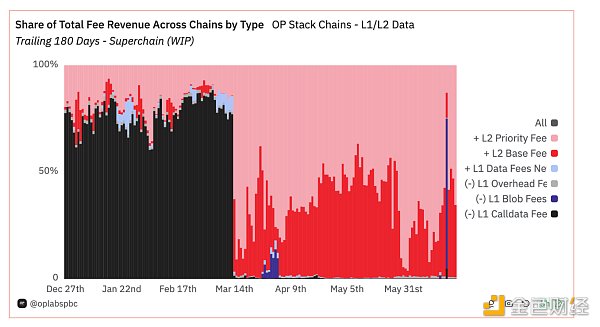
Since Dencun, L2 has paid a significant reduction in L1 fees - the chart shows a significant change in the gas cost breakdown of the OP Stack chain, with L1 costs falling from 90% to just 1%, while L2 costs now account for 99% of the total. This shift resulted in an overall drop of about tenfold in average total gas fees for L2, with average gas fees on OP Mainnet, for example, plummeting from about $0.50 per transaction to $0.05.

Subsequent surge in L2s activity
After the cost reduction, L2 activity and usage increased significantly, as shown in the figure above, L2 gas fees surged. Notably, on March 26, Base's average gas fee exceeded its highest level before the upgrade. In order to accommodate more transactions and reduce network congestion, Base increased its gas target starting around March 26th and made several adjustments since then.
The chart below focuses on the number of daily transactions on L2, showing significant growth for networks such as Arbitrum, Base, and OP Mainnet. Specifically, Base's daily transaction volume has increased fourfold and is now processing approximately 2 million transactions per day.
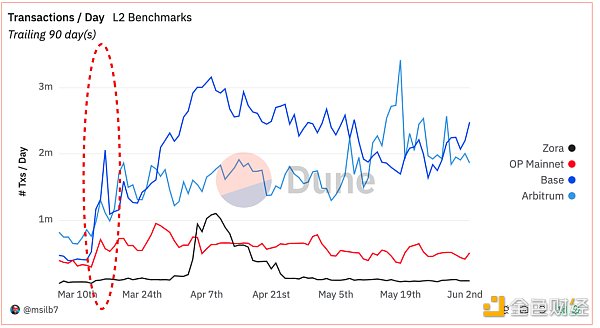
While it is difficult to determine whether this is the result of organic participation or influenced by incentive programs and Sybil activities, the number of active addresses and DEXs on all major L2s has increased significantly with the EIP-4844 upgrade, especially on Base and Arbitrum.

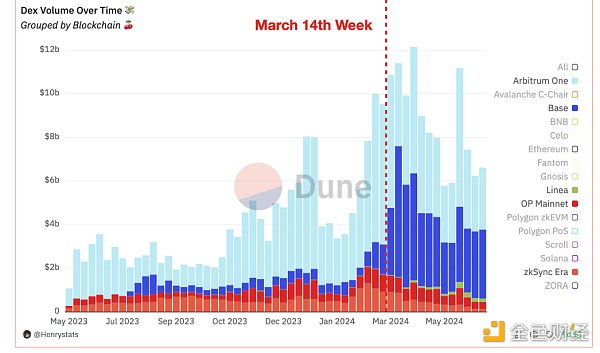
Assets moved to L2
With the improvement of market conditions and the memecoin triggered by $WIF on Solana With the arrival of the season, the total locked value (TVL) of L2 has continued to rise since the end of last year. Notably, Base has become the fastest growing chain, recently surpassing the total TVL of OP Mainnet.
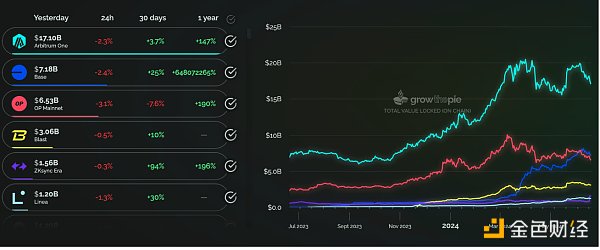
Since the beginning of March, Base's USDC inflow has been about $1.5 billion, part of which is Coinbase transferring customer and corporate funds to Base. According to Artemis statistics on 11 major bridges, the outflow of funds from Ethereum to the main L2 has reached $14 billion since January 2024. Arbitrum leads with around $7 billion in funding, followed by zkSync, Base, and OP Mainnet. Further data from Debridge Finance, a widely used bridge between EVM chains and Solana, confirms that Arbitrum and Base are the largest recipients of all outflows.

Bad News: Dark Forest Expands as Gas Prices Fall
When we further inspect transactions, we notice that bot trading activity is driving up gas fees and rebates on L2. We explore this more fully in the next section through a case study using statistics on Base, focusing on the impact of cheaper gas on L2s after the Dencun upgrade.
L2s after Dencun: Ethereum before Flashbots, but without the memory pool
Network congestion
Challenges have already begun to emerge: on March 26, Base's average daily gas fees briefly spiked, even exceeding the level before the Dencun upgrade. By June 3, Base had adjusted its gas target from 2.5M Gas/s at the time of the Dencun upgrade to 7.5M Gas/s, which brought the average gas cost back down to around 5 cents.
The contracts that consume the most gas on Base include Telegram trading robots such as Sigma and Banana Gun, as well as wallets and DEXs such as Bitget and Uniswap. In addition, a large number of unmarked contracts involve activities such as token minting, memecoin trading, and atomic arbitrage.
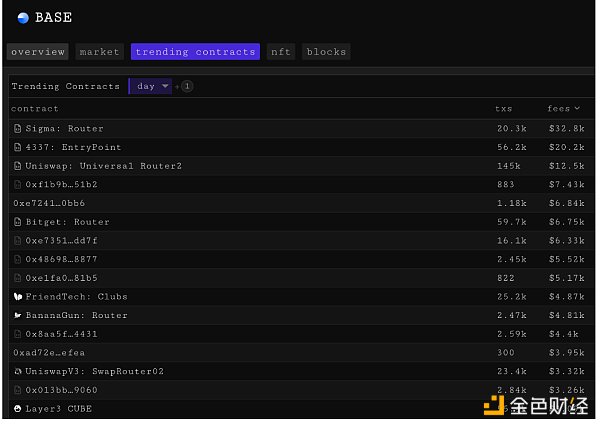
By comparing the behavior of popular Telegram Bot routers such as BananaGun, it is clear that their transactions incur much higher gas fees than other transactions. After the upgrade, users of the BananaGun Telegram bot paid a peak gas price of 30 Gwei when executing transactions on Base. The rate has since stabilized at around 3 Gwei, which is still 43 times higher than the gas fees paid by other transactions. Analyzing the average monthly gas prices paid by all popular DEX trading bots on Base and comparing them to all other non-Telegram-Bots transactions (black bars), it is clear that trading bot users incur significantly higher gas costs.

Return rate surges
Another important metric for blockchains is the transaction rollback rate across the network, from which we also observe an increase in transaction rollbacks on L2 after the Dencun upgrade - especially on Base, Arbitrum, and OP Mainnet.
Currently, Ethereum's rollback rate is around 2%, while Binance Smart Chain and Polygon's rollback rates are around 5-6%. Before the upgrade, Base's rollback rate was around 2%, but has since surged to around 15%, peaking at 30% on April 4. Similarly, Arbitrum and OP Mainnet have seen periodic surges in failed transactions, ranging from 10% to 20%.

After digging deeper, we found that L2's high rollback rate does not necessarily reflect the experience of every ordinary user. Instead, these rollbacks are likely coming from MEV robots.
Using the heuristics (queries) below, we identified a set of router contracts with similar bot activity — they appear to experience high recovery rates when performing MEV withdrawal transactions:
Active routers: This contract has processed over 1,000 transactions since the Dencun upgrade.
Limited interactions EOA: Fewer than 10 EOA (Externally Owned Account) wallets interact as transaction senders.
Distribution of senders: Less than 50% of transaction senders have only sent one transaction, indicating that the user base does not exhibit a long tail distribution. This suggests that routers are unlikely to be used by retail investors.
Behavioral Patterns: Trading histories either cover a full 24 hours or show multiple transactions within a single block, indicating non-human behavior.
Swap Concentration: More than 75% of successful trades involve swaps.
Detected MEV Txs: More than 10% of successful trades employ an atomic MEV strategy, as detected by hildobby's heuristics 2.
Using these criteria, we detected 51 routers that likely represent a conservative estimate of the lower bound of bot activity on Base.
We divided all Base transactions processed by routers into two groups for analysis. The comparison of recovery rates between bot-like routers and other routers is shocking: the average recovery rate for bot-like contracts is 60%, six times higher than the approximately 10% observed in other transactions.

From the above data, we can conclude that bot activities such as MEV bots and Telegram bots may be one of the main reasons for Base's high gas fees and rollback rate.
L2's single sequencer infrastructure, coupled with the lack of a public memory pool, has fostered the dominance of MEV strategies that involve a large amount of sequencer spam. These strategies have led to significant network congestion, especially on L2s that use Priority Gas Auctions (PGA), such as OP Mainnet and Base. The consequence is not only network congestion, but also wasted block space for reversing transactions and gas fees paid by MEV seekers. This situation reflects the state of Ethereum before Flashbots, with the notable exception that there is no MEV mezzanine on L2 due to the current lack of a memory pool.
How big is MEV on L2?
It is critical to gain a deeper understanding of MEV activity on L2. However, to date, there is no unified number for L2 MEV that has been verified through multiple sources and robust methods. In addition, there is a lack of real-time monitoring data similar to the work done for Ethereum (e.g. mev-inspect, libmev, eigenphi 3) to obtain L2 MEV volume and seeker profits.
Some of the L2 MEV datasets and research published to date include:
Open source datasets built by hildobby 2 on Dune Analytics (inspiration links: Sandwich 1|Sandwich| Atomic Arb 3)
Research paper funded by Flashbots, Quantifying MEV on Layer 2 Networks 1 by Arthur Bagourd and Luca Georges Francois, quantified MEV on Polygon, OP Mainnet, and Arbitrum using the mev-inspect implementation.
The research paper "Rolling in the Shadows: Analyzing MEV Extraction in Layer 2 Rollups"3 by Christof Ferreira Torres, Albin Mamuti, Ben Weintraub, Cristina Nita-Rotaru, and Shweta Shinde quantifies activity and discusses novel MEV strategies for L2 that leverage the role of sorters and their L2 batch confirmation latency
In addition to the above resources, Sorella Labs2 is about to release their MEV data indexer tool Brontes, which will be an open source repository that can be used for Ethereum mainnet and L2. Flashbots and the Uniswap Foundation are seeking grants to expand L2 MEV classification and quantification. If you already work in this field or are interested in collaborating, please contact the Flashbots Market Research team (@tesa on Telegram: @tesa_fb)!
While further validation is needed, hildobby’s dataset on Dune Analytics is a valuable initial benchmark:


Over the past year, the six major L2s (Arbitrum, OP Atomic arbitrage MEV volume on L2 (Arbitrum, OP Mainnet, Base, Zora, Scroll, and zkSync) exceeds $3.6 billion, accounting for 1% to 6% of all DEX volume on each chain respectively. This MEV volume is mainly concentrated in Arbitrum and OP Mainnet, but has recently shifted to Base and zkSync.
Compared to atomic arbitrage volume, sandwich volume on L2 is significantly lower, in stark contrast to the situation on Ethereum, where sandwich volume is four times that of arbitrage volume. This difference is due to L2's single-sequencer setup, which essentially does not introduce a memory pool, in which case searchers will not be able to perform sandwich MEVs and observe users' transactions from the memory pool (unless there is a memory pool leak or sandwiches from a single sequencer). Instead, strategies such as atomic arbitrage, blind rollbacks, statistical arbitrage, and liquidations are the most viable options for searchers on L2.

MEV market size
How much MEV revenue is left in L2?
While it’s difficult to accurately quantify the MEV market, we can check numbers from other ecosystems that have adopted MEV solutions for size comparison:
On Ethereum L1, MEV-boost blocks generate approximately $968 million in annual revenue for validators (estimated at $3,500 ETH); the median value of a MEV-boost block is 4x the value of a vanilla validator block.

On Solana, the additional MEV revenue collected by validators from validator tips through Jito’s bundling service (calculated at 50,000 SOL per week) is approximately US$338 million (estimated at a SOL price of US$130). While specific figures for Base’s MEV trading volume are unknown, the market size can be estimated by analyzing the revenue of the Banana Gun Telegram Bot, one of the most active bots in the space. The bot’s trading volume on Base as an L2 is comparable to its trading volume on Solana — consistently generating over $1 million in daily trading volume, and therefore over $10,000 in daily fees per chain.

Note that the market share of Banana Gun Bot on Solana and Base may be significantly different. For example, Solana has several other major Telegram bots, such as Sol Trading Bot and BonkBot, while Base may have fewer Telegram bots. Therefore, Banana Gun's sales volume does not translate into Base's total MEV revenue at its Solana revenue ratio.
However, consider another prediction using a different metric: In March alone, the Banana Gun Telegram Bot paid out over $23 million to Ethereum builders and validators! When comparing cross-chain transaction volumes, its volume on Base actually surpassed Ethereum in the week of March 26-April 1 (as seen in the spike in the chart above), indicating that the MEV earning potential on Base is huge.
Of course, the MEV ecosystems of Base and Ethereum are very different. Competition for MEV on Base is likely much less than on Ethereum, meaning the bot needs to bid to validators less often. However, memecoin trading bots operate primarily through blind sniping and arbitrage, which is still feasible in Base's sequencer setup.

Calling for MEV attention
Ethereum has built a complex MEV ecosystem with infrastructure tools serving participants at different levels of the supply chain. At the protocol level, MEV-boost allows validators to outsource the block building process through auctions. For searchers, bundled services provided by Ethereum's block builders (similar to Jito Labs on Solana and FastLanes on Polygon) enable searchers to propose MEV strategies with recovery protection. These services ensure that builders simulate transactions and process only those that are unrecoverable. Additionally, private RPC services like Flashbots Protect provide retail traders with a way to avoid public memory pools and the associated risk of being caught in the middle. L2 in its current form still has considerable room for progress in developing similar MEV infrastructure.
Why should we consider MEV solutions for L2?
Even without a memory pool, MEV still exists. MEV strategies such as statistical arbitrage (CEX-DEX arbitrage), atomic arbitrage (DEX-DEX arbitrage), and liquidations maintain market efficiency by clearing stale liquidity from AMM and lending markets.
However, without mature MEV infrastructure like bundling services, negative externalities will occur. Without a memory pool, most MEV strategies will default to a spam strategy, resulting in:
an increase in the reply rate of the entire network;
an increase in gas fees, leading to network congestion.
By introducing bundling services and shifting MEV competition pressure from on-chain to Sidecar, users are freed from the high gas fees of MEV robots. Seekers can also gain higher profits from recovery protection because the cost of failure can be reduced.
For L2s that aim to have a shared sorter, most solutions today require users to submit their transactions to a public memory pool, reintroducing the "mezzanine" phenomenon. At this point, MEV protection solutions (such as sending user transactions directly to private RPCs of block builders like Flashbots Protect) can provide protection against the “mezzanine” phenomenon, or even provide MEV or priority fee refunds, thereby providing better execution and better prices for users.
However, more complex MEV infrastructure still has some challenges. First, as the value captured by sequencers increases, the economics of search will change, causing searchers’ marginal profits to decrease over time. This, in turn, raises the question of how sustainable competitive search strategies are in the long run. We expect market forces to be at work here, with common search strategies paying sequencers most but not all of the value, and less common search strategies paying less value.
In addition, the order flow dynamics of existing MEV infrastructure (such as Ethereum’s block construction market) are still evolving rapidly. At the time of writing, they are a significant contributor to the centralization of the block construction market and the rise of private memory pools on Ethereum L1. How to ensure a competitive and fair block-building market remains an open challenge.
Finally, MEV solutions on L2 may also differ from those on Ethereum due to its unique properties of faster block times, cheaper block space, and relatively more centralized governance. It is unclear whether fast block times (such as Arbitrum’s 250ms blocks) are compatible with the current performance and requirements of existing MEV infrastructure. In addition, the abundant and cheap block space provided by L2 drastically changes the dynamics of search, which makes spam a more prominent problem and may require new solutions. Finally, L2 is relatively more centralized than other settings (such as Ethereum L1). In this case, it may be permissible to impose additional requirements on MEV service providers - such as requiring block builders not to cross-pollinate users - to achieve fair market outcomes.
 JinseFinance
JinseFinance



















